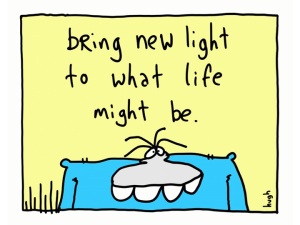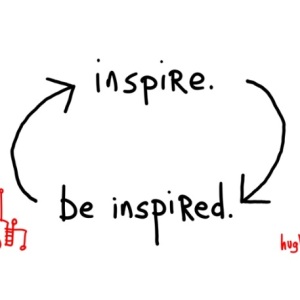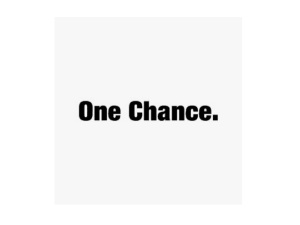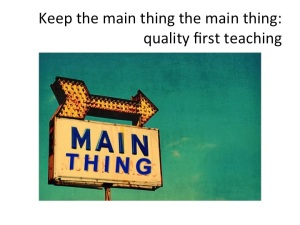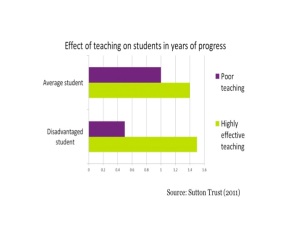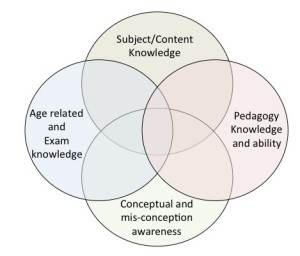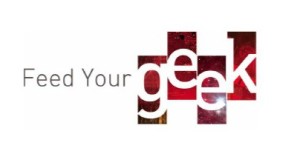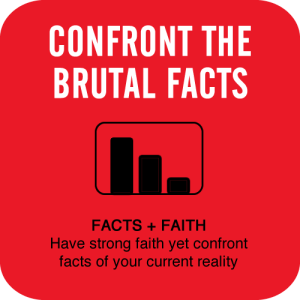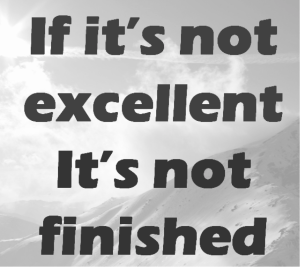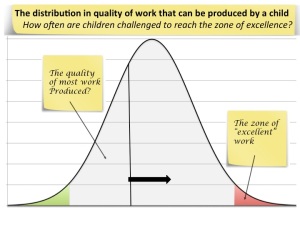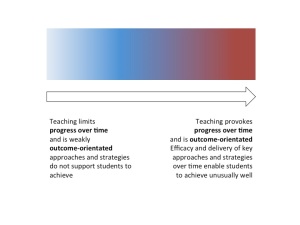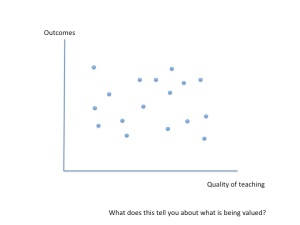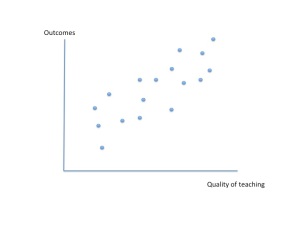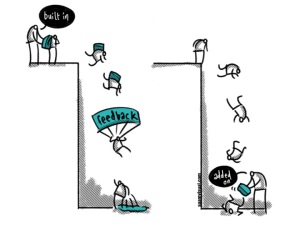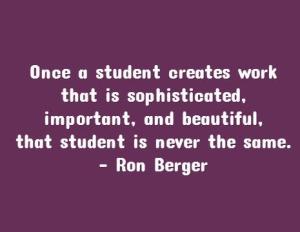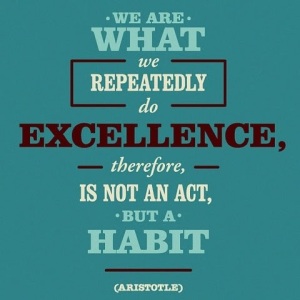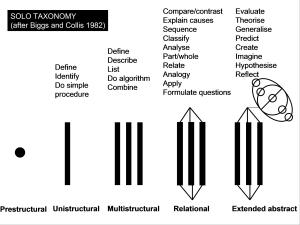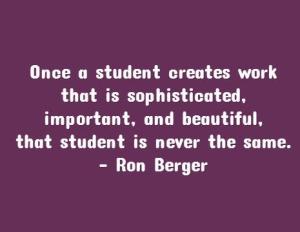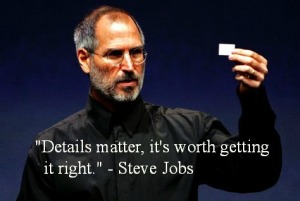“We have.. come to believe that an individual’s rank on narrow metrics of attainment can be used to judge their talent ..and ability.. and potential.” (adapted from Rose, 2106, “The end of Average”)

“Typing and ranking (against the average) have come to seem so elementary, natural, and right that we are no longer conscious of the fact that every such judgement always erases the individuality of the person being judged.” (Rose, 2016)

It is probably true that the removal of levels and Ofsted’s “no prescribed or preferred method” presents an enormous opportunity for teachers and leaders at KS3 (likely to refer to Year 7 and 8 for most – with the preference for three year KS4) to own the curriculum, develop assessment, improve pedagogy and inspire students to learn and progress into rounded, successful individuals (who also achieve well at GCSE and A-level).
This opportunity is likely to be enhanced in Multi Academy Trusts where scale provides a unique chance to drive-up standards and create world-class, shared, moderated approaches to curriculum, assessment, reporting and teaching in an area of the curriculum without external benchmarks. A chance to define specifically and focus on what students need to know, understand and do as the foundation for being and feeling successful.
It is also probably true that it is hard to avoid recreating a levelled system or to simply drop GCSE grades (or numbers) down through Key Stage 3.
“There are no ladders (progress is not linear), instead, each one of us has our own web of development, where each step we take opens up a whole range of new possibilities that unfold according to our own individuality.” (Fischer quoted in Rose, 2016)
It is also true.. that to move from levels at KS3 requires a shift in what is valued; a letting go of reassuring and convenient level descriptors, ladders of progress and grades. There is also an inherent danger that we will drift into a time of mediocrity and low expectation as schools and academies introduce non-standardised approaches across KS3 – an area that is presently riddled with underachievement, dips in progress and firmly in the shadow of performance measures at KS4. And.. there is additional danger that where KS3 is inept this will have a disproportionate impact on disadvantaged learners and those on the margins; widening gaps already open on entry to KS3.
And it is importantly true.. that primary colleagues have already moved to an age related / mastery approach. The 2016 results show 53% of students achieving the Age Related Expectations (AREs) in Reading, Maths and Writing (with the percentage achieving ARE in Reading (66%), Maths (70%), Writing (72% (TA)) and SPAG (72%)). Children entering secondary in September understand their attainment and to a lesser extent their progress against Age Related Expectations.
It is also true.. that the time for stalling on a life after levels approach at KS3 is over; not least because of the extraordinary opportunity that it provides. Almost half of all schools have dropped GCSE grades (or numbers) down through to Year 7 and 8 from GCSE (some dropping Progress 8 measures through the five years). Whilst this is both reassuring and convenient it offers no continuity with Primary approaches and essentially replaces levels with grades – particularly where these are fine graded and flipped to the new number grades… (replacing 4c with 4c, but less useful than the previous level because it relates to an equivalent performance projected to a distant summative exam, inherently narrowing the curriculum and experience of children)
However.. in a world without levels there is still a need to measure both the relative attainment and progress of students against a clearly defined age-related standards or expectations to measure the efficacy of the curriculum, teaching and to identify groups and individuals who fall behind, as well as ensuring that all students who need to deepen are stretched and challenged. And.. as Ofsted rightly identify there is a need to secure progress across all Years, in all subjects and across all groups and that where students fall behind they are caught up.
“When we are able to appreciate the jaggedness of other peoples talents – the jagged profile of our children – we are more likely to recognise their untapped potential, to show them how to use their strengths, and to identify and help them improve their weaknesses.” (Rose, 2016)
Which begs the question, what should an approach to life after levels seek to achieve at KS3?
What if.. we developed an approach that used well defined and rigorous Age Related Expectations across each subject and an assessment approach that measured both progress and attainment of children against these AREs and an approach to teaching and learning that inspired, deepened learning and brought the curriculum alive? What if.. was all enhanced through collaboration within a Multi Academy Trust?
What could that look like?..
What if.. this approach to KS3 had a fundamental influence on:
- The curriculum – so that it becomes absolutely transparent what every child should know, understand and be able to do. As well as affording the space and time to support teaching that deepens and stretches all children within Age Related Expectations. Building a curriculum that inspires children to enjoy and find life long passions across a broad and balanced curriculum – that answers, “what do we want young people to become, how can we give them wings and purpose in life?” as opposed to, “how can we prepare children to achieve an A grade (or 9) in 5 years time on a narrow summative exam testing areas that do not translate well to success in life?”
- Assessment – common summative assessments that test students against Age Related Expectations (requiring teachers and leaders to develop, create and moderate assessments, enhanced within a MAT or a Collaborative). Using formative assessment to close gaps, accelerate progress as well as catching-up those short of or falling behind the Age Related Expectations. Broadening our use of formative and summative assessment to include teacher assessment, coursework, book scrutiny, oral presentations, group working – to assess and support children to work at and deepen within ARE.
- Teaching and learning: Secure learning and progress of all children against the age Related Expectations of knowledge, understanding and skills. But, and here is the real opportunity, inspire and stretch children so that they deepen within the Age Related Expectations within a flexible, broad and balanced curriculum. Built in Formative feedback that has a strong influence on lesson planning and closing gaps to and beyond the Age Related Expectations.
What if.. we no longer equate speed of learning with ability? (Rose, 2016) What if.. we stopped labelling children as less able or more able; recognising that the key thing is that all have potential to attain well, regardless of their present level of attainment? The present level of attainment of a child is much more likely the result of background, chance, opportunity, linguistic privilege, context etc. than innate talent or ability. What if.. Age Related Expectations made explicitly clear how to close attainment gaps? And that.. the assessment and feedback woven into (and not bolted onto) the curriculum celebrates the jaggedness of children’s abilities and talents?
What if.. this new approach championed all subjects; Art, Music, Drama, PE, writing, poetry, sculpture, design, craft, reading, languages … because when students are enthused in their learning and they value increasing parts of it, they will also progress in literacy and numeracy as the vehicles for them to pursue their passions?
“Good Schools get on and do things: dance, drama, music, art, using the outdoors, speaking in other languages, finding out about the past and other places, growing things, cooking, going places, using ICT and paint brushes, making things, experimenting, learning about their own bodies, working out how to get on with others in the real world. Above all, they use all these experiences as vehicles to do amazing English and Mathematics to support the structured literacy and numeracy programmes at the same time bring purpose to learning for pupils.” (Mick Waters, 2013)
What if.. this extended to extra-curricular opportunities, not least because this does can unpick disadvantage and has been shown to have a significant impact on grades and progress. As Angela Duckworth describes extra curricular activities are, the playing fields of Grit. (When we talk of curriculum at KS3 we should retain “curriculum” in its broadest sense).
“When kids are playing sports or music or rehearsing for the school play, they’re both challenged and having fun.” … “There are countless research studies showing that kids who are more involved in extracurriculars fare better on just about every conceivable metric – they earn better grades, have higher self esteem, are less likely to get in to trouble and so forth. … more participation in activities predicts better outcomes.” (Angel Duckworth, in Grit,2016)
“Talent begins with brief powerful encounters that spark motivation (ignition) by linking your identity to a high performing person or group (or self image). This is called ignition, and it consists of a tiny, world shifting thought lighting up your unconscious mind: I could be them (or do that, or achieve that)” (Dan Coyle)
What if.. the present Year 7 and 8 Curriculum is so opaque, directionless and random that it actually works to enhance accumulated disadvantage? What if.. there was real clarity and consistency for all about the Age Related Expectations so that.. only motivation is the limiting factor for a child’s attainment. What if.. this disrupted the loop of unequal opportunity for students at the margins?
What if.. all of this had the ability to tackle workload through:
- The sharing of resources, SOW and curriculum planning.
- We did not seek breadth and focused on quality and depth of learning; reducing the burden on teachers; freeing them from the need to skim and teach at pace. Reassuringly clear clear about the key concepts and misconceptions, as well as the required Knowledge, Understanding and Skills.
- Centralised assessments and reporting to generate real clarity of expectation.
- Curriculum groups and CPD to have clear direction around, for example, the key Year 7 concepts and misconceptions. This will bring shared purpose to departments across Academies.
- Establishing shared exemplars for the Age Related knowledge, understanding and skills in Year 7 and 8 to support modelling and acquisition of AREs.

What if.. the very first question that we ask is, “what should students at the end of Year 7 (and 8) know, understand and be able to do?” ..in each subject? (and across the full curriculum?)
“Our task is to educate their whole being so they can face the future. We may not see the future, but they will and our job is to help them make something of it.” (Ken Robinson)
What if.. it is much more about developing successful individuals, historians, geographers, musicians, artist, sportspeople, scientist, writers, innovators, dreamers, mothers, fathers, positive citizens.. and that KS3 is about this grounding across all of these areas within a broad, balanced, inspiring, motivating curriculum … Then the question is what do we, as professional teachers, subject specialist and leaders, want our Year 7 (8, 9) children to know, understand and do? Ensuring that we set our expectations high enough.. (and on from Expectations at KS2)..
“The greater danger for most of us lies not in setting our aim too high and falling short; but in setting our aim too low, and achieving our mark.” (Michelangelo)
What if.. we also realised that there should be only one set of expectations – the Year 7 Age-related standard – And we avoided describing any sort of level on the way to this standard or beyond. We became comfortable that the Age Related Expectation is just that. And in a similar way to Ofsted who provide no descriptors for Requiring Improvement (it is not yet good) .. students are “working towards age related expectations” (Of course it may well be helpful to use departing levels, KS2 Age Related Expectations and even GCSE descriptors to inform and support shared construction of the Year 7 Age Related Expectations and the Year 8 AREs … BUT we should resist on-going comparisons and remove levels and grades from assessment – there is no life after levels if levels or grades or a proxy still exist – AREs are single statements of what is expected by age, no ladder through them just distance from ARE and deepening within ARE)
What if.. it is also unhelpful to try to align the Age Related Expectations to GCSE grades or numbers. Whilst you would expect a child working at Age Related Expectations to go on and achieve at least a “good pass” (at least a 5 (1-9)) and that through deepening and pursuing excellence will access 6-9 at GCSE, we should resist placing age related expectations on a graduated scale or flight path across 7-11. Not least because KS3 should be about progress and preparation for life across a broad and balanced curriculum, that learning should spiral and interleave and that assigning a child as an F, G, H in Year 7 is a non-sensical descriptor of their attainment that ignores progression in learning. We should tread carefully if we try to force-fit summative GCSE grading down through to Year 7, even if there is a level of convenience in drawing on GCSE descriptors, questions, mark schemes etc. What if.. a better fit is to base all types of assessment to percentages or standardised scores of 100 and then determine percentage of performance that relates to working at Age Related Expectations? – (banding that can to planned into tests or derived through moderation post-assessment).
What if.. Knowledge is Power and that this should be a key focus for a Age Related Curriculum? What if.. the acquisition of knowledge allows the proximal zone of development to widen so that progress accelerates as students are more able to assimilate new information/understanding/skill with their existing ability. What if.. this is more important from disadvantaged students who age 3 have half the words of children from professional families? (553 words v 1100 words) What if.. therefore, our KS3 curriculum and Age Related Expectations emphasised the required knowledge and this was made accessible, transparent and secured through quality first teaching .. so that effort (motivation) was the only barrier to acquiring the required age related knowledge?
What if.. instead of levels or grades we were only interested in children working towards Age Related Expectations at KS3 (following the primary model), achieving the AREs and importantly being given the freedom to deepen their knowledge, understanding and skills within these Age Related Expectations? We might describe a child as..
- Deepening (D): child has reached the year group expectation and is now taking this deeper into more abstract work – following their passion within a broad curriculum that inspires the full range of talent and interest.
- On track (O) / Working At current age related expectation. Child is working at the age related expectation for the Year group.
- Yet to be on track (Y): the child shows some working at age related expectations but is not on track to achieve them.
- At an earlier stage (A) in their learning journey. The child is short of the age related expectation.
(…and we resisted trying to describe any stages before or beyond age related expectations, which would recreate levels)
What if.. these tracked onto the national criteria at KS2?..

What if.. we tracked both attainment and progress against age related expectations (ARE) using the following?.. for whole cohort (Year group or MAT Year group), groups, subjects, classes etc. … enabling inter and intra Academy and subject and group comparisons.

What if.. this shows where students enter year 7.. using the KS2 scaled score. (where >100 reflects “Working at Expected Standard” on the x-axis? That in-line with Progress 8 this is the average of Reading and Maths. (53% of students achieved >100 (scaled score) in Reading, Writing and Maths. (SPAG being the fourth area measured at the end of KS2.
What if.. we used blue to identify non-PP, orange to identify PP children, triangles for female and circles for male and that an SEND child is shown by a black border?..AND what if.. as you rolled over each symbol the name and class of the child popped up?

What if.. we used the y-axis as a 100-scale – most likely to be linked to a summative assessment (percentage) that identified children’s present attainment against Age Related Expectations.. What if.. the measure of a child’s attainment against Age Related Expectations could be given through teacher assessment, practical scores, oral presentation against set criteria?
What if.. the child’s vertical position identified their present attainment or distance from, on or beyond Age Related Expectation? AND that vertical movement up or down is a reflection of progress toward or away from the Age Related Expectation..

What if.. we could plot over 1000 students against these Age Related Expectations (a benefit afforded by being part of a Multi Academy Trust)? What if.. this created a unique opportunity to moderate and standardise performance against a significant sample of children in each year (n.>1000), in each subject across all classes and groups? What if.. this was a significant nudge that raised standards at KS3?
What if.. we presented this data for each subject? ..or group? ..or class? So that..
- We were able to track cohort percentages of the attainment of students – e.g. 63% at or above ARE
- We were able to track the progress of students – e.g. of those starting at ARE and above at the start of Year 7, 40% are gaining ground against ARE, 52% are falling behind
- We can visually and directly see who is falling behind … and intervene.
- We can compare the attainment and progress of groups, particularly focused on groups.
- We can measure the progress of students by class – a class that is moderated across a number of schools – in a student cohort of >1000, across 8 Academies.
What if.. we described progress over time against Age Related Expectations as:
- Accelerating progress against Age Related Expectations
- Gaining ground against Age Related Expectations
- Maintaining progress against Age Related Expectations
- Falling behind against Age Related Expectations
- Falling further behind against Age Related Expectations
And.. these could be used with the attainment against Age Related Expectations: Deepening ARE, At ARE, Yet to be at ARE or At an Earlier stage (as above).
What if.. this allowed very clear identification of the children who are falling behind from where they were against the clearly defined Age Related Expectations?.. what if.. this told us about PP or SEND or gender or academy or department or individual? what if.. we did a work scrutiny and student voice for those students falling behind, and actively caught them up?

AND.. those that are gaining ground from where they were against the clearly defined Age Related Expectations.. so that we can grow bright spots, celebrate and share practice that accelerates the acquisition of knowledge, understanding and skills..

What if.. our job as educators just became very straight forward … all children regardless of present attainment need to be supported to reach the Age Related Expectations and for those who are secure to deepen and further bring alive and broaden the curriculum. So that the standard deviation shrinks and attainment rises (or deepens!)… seeking this…

OR more simply.. to get all up to the standard and to deepen within the curriculum to inspire the next generation of mathematicians, writers, readers, sculptors, actors, artists, play writes, composers, biologists, astronauts, comedians and so on? against deepened AREs … and without levels and/or grades.
AND What if.. this just required:
- a set of rigorous and well crafted Age Related Expectations – cleverly described and accessible…(to students, teachers, leaders and parents) Expectations that develop over time (through moderation and the professional dialogue of subject specialists) to articulate ever more clearly the expected knowledge, understanding and skills?
- a set of common assessments that are 2/3 times a year sat across all Academies., as well as a suite of other summative and formative assessment techniques?
BUT we need to.. remember that we can also measure whether children are working at age related expectation through teacher assessment, through the quality of books, practicals, presentations, group working etc. After all this should really focus on the quality of formative feedback and importantly how this informs and shapes teacher’s planning.
What if.. the real benefit is that children, teachers, leaders, parents etc. will know much more precisely what they know, what they do not know, understand or can do … and importantly how they can close gaps in their learning. This may help to replace the patchwork of lucky breaks…
“(KS3 needs to…) replace the patchwork of lucky breaks, context and arbitrary advantages that determine success…with a system (curriculum and teaching) that provides opportunities and the conditions for all to feel success.” (Malcolm Gladwell, adapted)
What if.. ALL OF THIS is compromised if we do not invest time in establishing outstanding Age Related Expectations. AND what if.. even with this we need to support the development of teaching to secure deepening of ARE, the quality go feedback for planning lessons, feedback for children and the ability to broaden the curriculum to inspire and secure a passion for deeper learning.
What if.. we need to become excellent at setting ARE summative Assessments? as well as teacher assessment, coursework, practical assessments etc. to judge children against Age Related Expectations. Where Multi Academy Trusts have scale they become their own Exam Board for KS3 with paper setting, expectation setting, moderation, reporting and feedback. The moderation, CPD, sampling, ARE reporting, ARE data will grow our understanding of ARE over time; clarifying and improving the Age Related Expectations and the quality of Assessment (and feedback).
What if.. the age related expectations are clearly communicated on single sheets that show the specific gaps in what children know, understand and can do? – not dissimilar to PiXL Covey tables or PLC grids…a DTT approach. What if.. deliberate practice approach is then used in lessons, at parents evenings, in reports and through intervention to close gaps.
What if.. this allowed reporting and parents evenings to have the structure of…
- Your child is gaining ground (or falling behind) in their learning towards age related expectations. (progress)
- She is presently short of Age Related Expectations (Attainment)
- What she specifically needs to do to secure Age Related Expectations is … and this … and that … (Targets)
- And here is the specific Age Related Expectations that I have colour coded to show you where there are gaps and these link to specifically how you (and we) can support your child to go beyond ARE and deepen in these areas…
- For every subject at KS3.
What if.. this enabled us to plan, teach and intervene to: catch-up those who fall behind, ensuring all achieve ARE, deepen children’s knowledge, understanding and skills within the Age Related Expectations and stretch and challenge all to release their passion for learning within a deep and challenging curriculum – inspiring excellence
What if.. all of this required great teaching … perhaps most importantly emphasising..
- Feedback that inform planning of lessons against ARE and specifically what students can and cannot yet do. (More reading/marking for planning over marking to the individual)
- Questioning that secures and deepens key concepts and challenges mis-concepts by age. Focusing on the acquisition of knowledge, understanding and application.
- Deepening and challenging lessons that bring the curriculum to life and to depth to challenge all learners to ARE and to deepen beyond.
What if we then further embed ideas around Blooms and SOLO taxonomy? That “by age” we were very clear about what is expected (what competences children need to have or be able to do?)…and that this provides the framework for depth, teaching, questioning etc. as it already does in many classrooms.
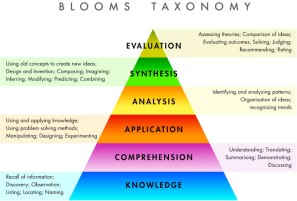

What if we taught to depth around these age related expectations because the necessity to cover lots of content is removed. What if there was a real stickiness around redrafting and re-doing, such that children were challenged to do their best work and this enabled students to spend more time working at Age Related Expectations?
“More generally, in top performing education systems the curriculum is not mile-wide and inch-deep, but tends to be rigorous, with a few things taught well and in great depth.”
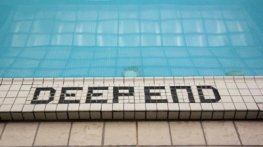

What if all of this also sought the ethic of excellence, because…
“Once a student sees that he or she is capable of excellence, that student is never quite the same. There is a new self-image, a new notion of possibility. There is an appetite for excellence.” (Ron Berger)
What if.. this seeking excellence required an unswerving expectation that all teachers were purposeful, deliberate and precise around formative feedback and that this was within tasks and lessons and not bolted on. What if.. we judged the quality of feedback much more on the quality of what students produce and less on ticks or comments or forced dialogue in books.
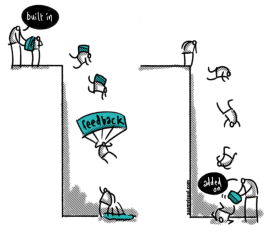
What if.. the curriculum was interleaved so that the Age Related Expectations are re-visited to embed and secure new knowledge and understanding? What if.. we developed a spiral nature to the curriculum?
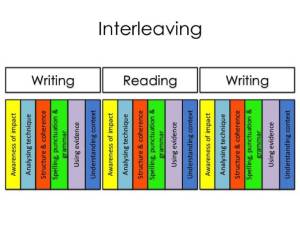

Maybe then we would have an approach to life after levels that..
- was focused on developing successful individuals, historians, geographers, musicians, artist, sportspeople, scientist, writers, innovators, dreamers, mothers, fathers, positive citizens.. as identified by subject specialists in our Academies.
- took control of the curriculum, assessment and teaching against a clear set of Age Related Expectations that importantly allow teaching to deepen and inspire within the expectations.
- built on the Primary experience of Ager Related Expectations and Mastery and provided a strong foundation across a broad curriculum – including
- was able to measure attainment and progress to identify those that fall behind.
- was clear about the precise Age Related Expectations for Year 7 and 8 – so that children understood the knowledge, understanding and skills that they can and cannot do and importantly the gaps in their learning and importantly how to close them.
- did not recreate levels in a new format or simply use GCSE grades or numbers down through to Year 7. It did not seek to provide any other descriptors other than one set at Year 7 and one at Year 8 – the child is either at an earlier stage, yet to be at ARE, working at ARE, deepening within ARE.
- took full advantage of Multi Academy Trusts and Collaboratives to own and develop standardised approaches that sought to raise the bar. That charged subject specialists with developing AREs and Common assessments (summative and other) that brought real ownership of what and how knowledge, understanding and skills are secured in our young people.
- had a sophisticated way of visually showing the attainment and progress of all children, by year, group, class … Academy, department etc. So that progress of a child is identified as accelerating progress, gaining ground, maintaining progress, falling behind or falling further behind.
- never forgot that it is still the quality of teaching in each lesson every day that is the transformative engine of education regardless of the curriculum.
- had at its heart a drive to close gaps for the disadvantaged and children on the margins. In fact catching-up all those who are and fall behind.
“An individual is a high-dimensional system evolving over place and time.” (Molenaar, in Rose 2016) “…if we demand that social institutions value individuality over the average, then not only will we have greater individual opportunity, we will change the way we think about success – not on terms of our deviation from average, but on the terms we set for ourselves.” (Rose, 2016)
What if.. it was precisely this opportunity to take control of the curriculum, assessment and teaching that inspired us all to enter Education and seek to make a difference?
Dan Nicholls | August 2016
Thoughts and ideas largely my own and do not necessarily reflect that of the Cabot Learning Federation.




















